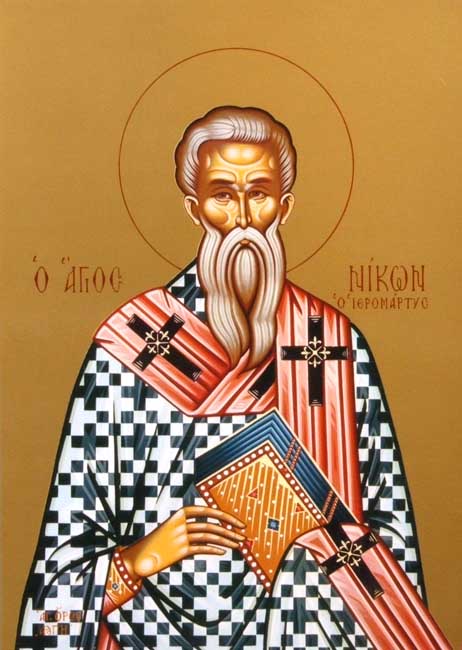 Most likely he was from Naples, Italy, although some suggest he was from Caesarea, Palestine. His father was a pagan and his mother was a Christian.
Most likely he was from Naples, Italy, although some suggest he was from Caesarea, Palestine. His father was a pagan and his mother was a Christian.
Once, during a military battle in which Nikon took part, he found himself in great danger. At that very moment, what he had heard from his pious mother about eternal life occurred to our saint, so he cried out: “O Lord Jesus Christ, come to my aid!” Armed with the sign of the cross, an invincible weapon, he rushed into battle with such great courage and strength that he emerged victorious and glorified. On his return to his homeland, he visited his mother and related what had happened to him. He also conveyed his desire to be baptized in the East, where the springs of faith are.
Nikon traveled by sea to the East. Arriving at the island of Chios, he secluded himself in a mountain, where he spent a whole week in fasting, vigils, and prayer, preparing for baptism. An angel of the Lord appeared to him, gave him a staff, and told him to go down to the shore. There he found a ship, which took him to the summit of Ganus in Thrace, where he met Theodorus and Thila Theodosius, Bishop of Cyzicus, who had secluded himself in that region as a hermit in a cave. The latter seemed to have known, with God’s help, that Nikon was coming. So he invited him to his seclusion, taught him the fundamentals of the faith, and baptized him in the name of the Holy Trinity. Our saint remained in the place to which Divine Providence had led him, walking in all things in the footsteps of his spiritual father. Three years passed, after which Theodorus ordained him a priest, and it was also said, a bishop. When the hour came for Theodorus to depart, he entrusted him with the leadership of one hundred and ninety disciples who had gathered around him.
Meanwhile, the persecution of Christians by Decius Caesar (251 AD) was raging, and Nicæus and his companions found themselves forced to travel by sea. When they reached Italy, Nicæus was able to visit his dying mother and participate in her burial. He also baptized nine of his countrymen who had abandoned their families and decided to join him.
After this the two hundred monks went to Sicily. They settled on the summit of Taphromina. However, they did not enjoy peace there except for a short time, for the pagan governor of Sicily, named Contianus, learned of their presence, seized them, and brought them before him for trial. The disciples of Nicene, with one voice, refused to renounce Christ and their blessed service. The governor handed them over to be flogged with cow sinews, then cut off their heads and threw their bodies into hot water furnaces.
Then it was Nikon's turn. He was stretched out on the ground, his hands and feet were cut off, and the soldiers beat him with torches. Then they tied him to two bulls and led him to the edge of a valley. They threw him from a height, but he did not die. They smashed his jaws with stones, cut out his tongue, and cut off his head. As for his remains and the remains of his companions, they were found by the Bishop of Messina, Theodosius, who built a church in their honor.
According to one account, after Nikon's death, his body remained in the field to be food for the birds, but a demon-possessed shepherd boy fell upon the body and was immediately healed. He spread the news, and someone came to take the body and bury it.
Our Orthodox Church commemorates him on March 23, 2017 Eastern, April 5, 2017 Western.


